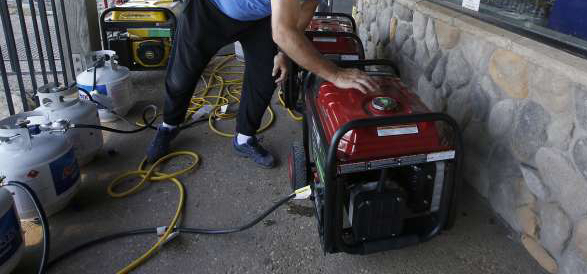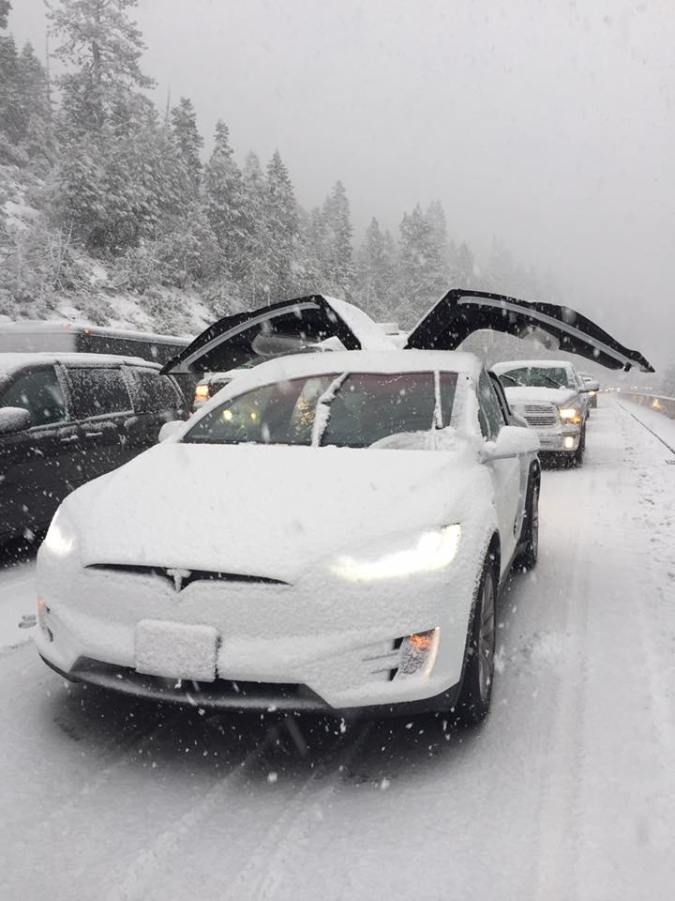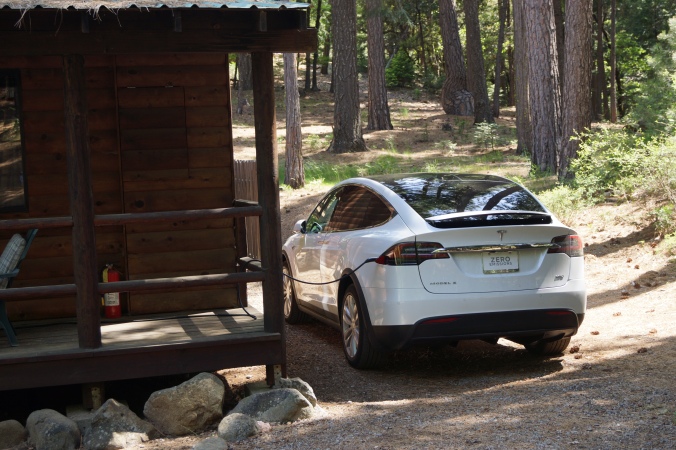2020 has been tough on a lot of us, especially since our weak leadership and apparently coordinated fake news campaigns have confused enough people to fail to protect themselves and others with masks, and has us stuck with a much more severe outbreak of covid than any other developed country in the world.
Things have changed forever, and we are slowly getting used to a new reality of working from home, remote school attendance, and monitoring not just the weather but also the death rate and infection rates due to covid.
Grid tied solar gets shut down by PG&E in grid power outages
Living with solar power since 2015 has been a boon in terms of reducing fuel cost and not feeling powerless (haha) when PG&E shuts down the local grid in a desperate effort of wildfire prevention. In those events, grid-tied solar actually gets shut down as well, to prevent feeding of power into the grid while crews are potentially doing maintenance in your neighborhood.
A workaround we had already designed into our 10kW solar system in 2015, was to have inverters that allow manually disconnecting from the grid, and using an emergency power outlet to consume some of the solar generated energy instead of it evaporating unused altogether. Before working from home was a thing, we figured, we can survive without the AC running, as long as we can run a long power cord to the fridge and freezer to avoid food from spoiling.
2020 a new reality, working from home
2020 with the new reality of working from home, 100F summers, and a memory of extended power outages in 2019, our neighbors and us were looking at generators, but handling fossil fuels and doing maintenance on those and dealing with their noise just felt so… 1960 ?

Thankfully California has a rather generous self generated incentive program (SGIP) that along with the federal solar investment tax credit (ITC) which applies to solar and home battery installations, makes home batteries actually affordable and amortize in less than their lifetime.
So in March, we finally got an installation of three Powerwalls. Why three?
Three is better than two, especially if the price is the same
We originally asked for quotes for one or two. Since we wanted to run the whole house off of it and not have to worry about only powering and separating out critical circuits (fridge works, AC doesn’t etc) we were pretty set on two home batteries. Using three however allows you to use a different tier of the SGIP which essentially pays for the third battery, and was not as oversubscribed as the default tier.
So now we have 40kWh of capacity backing our home, and spikes of use from AC running at the same time as the electrical dryer and cooking are just going to be covered regardless of power outages or not.
Smart automation
The powerwall software is actually pretty smart, using machine learning and energy forecasts (weather implying AC use) in order to take advantage of our EV2-A PG&E time of use plan, which has different per kWh pricing depending on the time of day.
Time of use based electricity rate plans, net metering
Solar homes usually are selecting a time of use rate plan that incentivizes donating your surplus of electricity generated to the grid with higher prices at day, while consuming cheap mostly unused electricity at night.
The beauty is that with a so called net-metering agreement, you get billed yearly for the difference between all you consumed and all you produced, and they give you pennies on the dollar if you produced more than you consumed, or bill you regular prices if you consumed more than you produced over that year.
EV-A, the too good to be true plan
We used to be on the EV-A plan, which I would call the ‘too good to be true plan’ which would perfectly align with solar homes and electric driving in pre-covid times. You charge your cars over night, and they are full in the morning, paying $0.13/kWh. While you are away from home, and parked at your workplace, your home solar produces electricity from about 8am to 8pm, which happens to be credited at $0.25/kWh mid-peak and $0.45/kWh at peak time. This makes sense because this is also the time that other neighbors of yours use the most electricity running their air conditioning and cooking lunch or dinner, so it’s the perfect time to donate your surplus energy.
I call this the too-good-to-be-true plan because it essentially stretched our daily solar production which can range from 15kWh to 60kWh depending on time of the year to almost three times that when we used most of that at night for charging our cars. It’s as if the grid is your battery, unless there are power outages, but that gives you 3 times the electricity at night for the same cost as what you donated it at day.
In consequence, until we added solar in 2015, we used to pay $2400/year to PG&E, and from 2015-2020 we paid less than $100/year, each year, in return to supplying
All good things have got to come to an end. RIP EV-A, here comes EV2-A
Eventually PG&E had to fix this situation, and they went a bit overboard. They forced us from the EV-A plan to a new EV2-A plan, which basically gives you lowest price for your solar generated power until 3pm, mid-peak pricing till 4pm, and peak pricing from 4-9pm. Also the off-peak rate is now $0.17 instead of $0.13. Incidentally, homes in our climate also need the most AC from about 3pm when the heat outside is the highest. I bet you can tell how that this is a much worse deal for the consumer/producer already, while being more fair to PG&E by pricing electricity higher when it is actually in higher demand.
Yay, driving with solar power !
Now because of covid and working from home, this actually coincides somewhat nicely for us. The car is parked and connected to the charger at home most of the day now. Instead of charging the car from a partially dirty power mix at night, we now can charge from 100% clean solar power until 3pm at the same price as over night.
Guilt free acceleration!
But with us driving so much less while working from home, that is actually not as much of a big deal as before.
Time shifting demand
The Powerwalls now allow us to absorb the solar energy produced from 8am to 3pm and use the cheap off-peak grid electricity until then, and stop using the grid electricity from 3pm to midnight, allowing at least most of the solar power generated between 3pm and 8pm to be fed to the grid and compensated at peak pricing instead of partially being used by our home.
This means, our power hungry AC, dinner cooking, electric dryer etc, runs off of the battery when the per kWh price adjusts up, and should allow us to still not pay much for electricity per year, despite the devastating change in compensation plan that EV2-A brought.
Where there is light, there is shadow
So what are the downsides to adding a home battery in covid times?
First off, understand that the SGIP comes with certain restrictions, and I have not fully understood all the nuances of why it is this way, and how much is regulations due to SGIP and how much because of other details of PG&E and powerwall operation permits:
Being able to shift power does NOT mean you can charge your battery at night at low price and deplete it in the day at highest price, cashing on on the arbitrage.
It only allows consuming self generated power from the battery, which ideally you do at peak while donating all currently generated solar power to the grid instead of consuming part of it yourself.
Thankfully you don’t have to sit and micromanage any of that yourself, because the powerwall has an advanced mode that uses machine learning and energy forecasts to adapt the flow of power in your home as needed.
The surge in demand by more and more people working from home, and PG&E having scared so many people in 2019 with random long lasting power outages, makes it difficult to get reasonable timelines and correct answers on incentives. Talking to Tesla, their sales person outright said, SGIP incentives are already oversubscribed, buy it without it, or look at third party installers that are not tapped out yet. Some people are waiting months to get theirs.
We got ours installed by a local installer that was working with us to secure SGIP.
Another downside is that now that I can infer through the near realtime power consumption graphs in the Tesla app what consumes how much, I am even more obsessed with efficiency, and want to upgrade the insulation on the home next.
By having the project happily scoped with SGIP offsetting the sizable total cost in the end, this will affect the property value from a property tax standpoint and cost of property tax per year will go up, clawing back some of that incentive over time.
Lastly, the software using machine learning to adapt to the time of use plan is far from perfect, and switching modes manually as you try to make it better, it confuses the algorithm further. This can be quite aggravating to observe.
Where there is shadow, there is light
While the machine learning based power control automation doesn’t always seem to do the right thing yet, the powerwall updates its software automatically as new versions get released, so performance and feature improvements will happen over time, just like with our cars.
Also it has a storm watch mode, i.e. when an extreme weather event is on the horizon, if enabled, the powerwall will actually charge from grid and solar at the same time to minimize time to 100%, and reserve the power in case there is a prolonged power outage. Note this also triggered when rolling outages where a thing because of extreme heat and unusually high electricity demand from air conditioning.
Where there is light, there is a future
Being powered on sunlight overall is great. According to rumors, Tesla may have battery technology breakthroughs lined up that allow future cars and home battery and solar homes to eventually be part of a virtual power grid that uses an autoarbitter software to shape the individual contributors demand and supply of energy to coincincide better with the grids needs. So rather than having fixed time ranges in a time of use plan, I imagine there will be dynamic pricing that allows the grid to not be impacted when a central power plant goes offline temporarily. It may very well allow us to shut down not just coal but also gas peaker plants, and generate revenue for the homeowners to offset their investment into power infrastructure. We will learn more about their ambitious plans at battery day which has been rescheduled to September 2020 last time I checked.

















